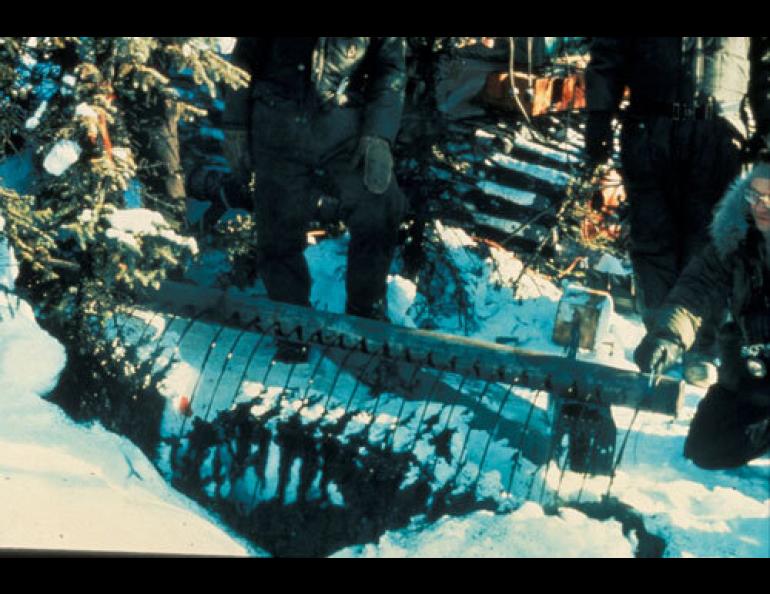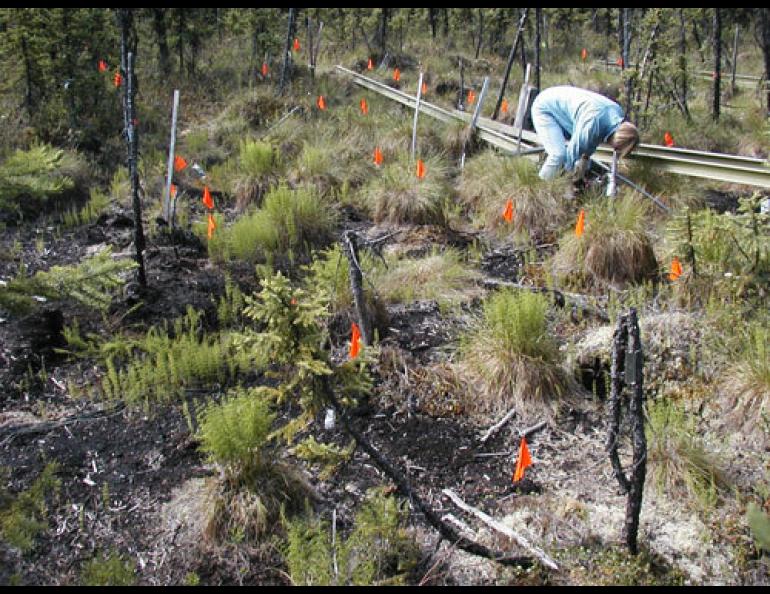

Oil Spill Persists for Nearly 30 Years
On a cold day in February 1976, about 2,000 gallons of steaming Prudhoe Bay crude oil spilled over the snow and percolated into the frozen floor of a black spruce forest. Much of that oil spill remains today, even after a wildfire burned through the area last summer.
The 1976 oil spill that killed more than 40 black spruce trees and almost all the vegetation around them was no accident. Scientists with the Cold Regions Research and Engineering Laboratory dumped the oil on the muskeg in both summer and winter that year to simulate what might happen if the soon-to-be-built trans-Alaska oil pipeline sprung a leak in a black spruce forest underlain by frozen soil, a common environment in Interior Alaska.
That site, in the Caribou-Poker Creeks watershed north of Fairbanks, still has not recovered from the manmade oil spill, according to Jessica Garron, of the UAF Forest Soils Lab. Garron is completing a master’s degree project about the site under the guidance of her advisor, UAF microbiologist and Dean of the College of Natural Science and Mathematics Joan Braddock
“Nearly 25 years after the oil spill, only 10 percent of the oil in mineral soil has been degraded. In the organic layer, 40 percent has degraded,” said Garron at a recent chemistry conference in Fairbanks. “If Alaska were in the tropics, a month after the spill there’d be serious changes.”
Bacteria in the soil can consume crude oil, but they work better in places where plenty of soil nutrients, water, and warmth exist. Both Garron and Braddock think the Caribou-Poker creeks oil spill area is short of nitrogen and probably limited in oxygen.
While Garron was studying the site in the summer of 2004, a wildfire swept through. Still, the circa-1976 crude survived.
“The hydrocarbon chemistry hasn’t changed much after the burn,” Braddock said. “There’s tons of oil out there still.”
Garron said the wildfire that burned through her study site stimulated microbes that might help clean the hydrocarbons from the soil in time. On the site, horsetails have now joined sedge tussocks, one of the few plants to survive the oil spill.
The intentional oil spill has persisted for decades at Poker Creek. By contrast, an area that absorbed the most famous accidental spill in Alaska’s history has recovered to a large degree. In a paper published in Environmental Science and Technology, Braddock and others estimated that in 1992, about 20 percent of the oil spilled in 1989 from the Exxon Valdez had evaporated. Clean-up crews recovered about 14 percent, about 13 percent was still in Prince William Sound beach sediments, less than one percent remained in the water, and 50 percent underwent biodegradation, a process in which microorganisms fed on the crude oil and convert it to carbon dioxide and water vapor.
The cleansing ability of microscopic creatures also was apparent in a fuel spill in Barrow in the mid-1990s that was treated with nitrogen Braddock and others stirred into the gravelly soil.
“Within a summer, it was clean,” Braddock said.
The persistence of the 1976 spill near Poker Creek seems to indicate that black spruce growing above permafrost, one of the widest spread ecosystems in Alaska, is also one of its most fragile.
“The black spruce environment is probably one of the trickiest to clean up after a spill,” Braddock said.






